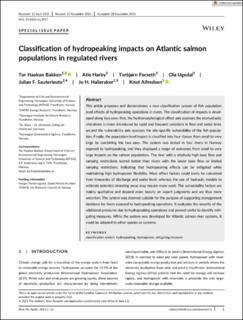| dc.contributor.author | Bakken, Tor Haakon | |
| dc.contributor.author | Harby, Atle | |
| dc.contributor.author | Forseth, Torbjørn | |
| dc.contributor.author | Ugedal, Ola | |
| dc.contributor.author | Sauterleute, Julian Friedrich | |
| dc.contributor.author | Halleraker, Jo Halvard | |
| dc.contributor.author | Alfredsen, Knut | |
| dc.date.accessioned | 2022-03-09T08:51:31Z | |
| dc.date.available | 2022-03-09T08:51:31Z | |
| dc.date.created | 2021-12-20T09:21:03Z | |
| dc.date.issued | 2021 | |
| dc.identifier.citation | Rivers Research and Applications: an international journal devoted to river research and management. 2021, . | en_US |
| dc.identifier.issn | 1535-1459 | |
| dc.identifier.uri | https://hdl.handle.net/11250/2983895 | |
| dc.description.abstract | This article proposes and demonstrates a new classification system of fish population level effects of hydropeaking operations in rivers. The classification of impacts is developed along two axes; first, the hydromorphological effect axis assesses the ecohydraulic alterations in rivers introduced by rapid and frequent variations in flow and water level, second the vulnerability axis assesses the site-specific vulnerability of the fish population. Finally, the population level impact is classified into four classes from small to very large by combining the two axes. The system was tested in four rivers in Norway exposed to hydropeaking, and they displayed a range of outcomes from small to very large impacts on the salmon populations. The river with a relatively high base flow and ramping restrictions scored better than rivers with the lower base flow or limited ramping restrictions, indicating that hydropeaking effects can be mitigated while maintaining high hydropower flexibility. Most effect factors could easily be calculated from timeseries of discharge and water level, whereas the use of hydraulic models to estimate potential stranding areas may require more work. The vulnerability factors are mainly qualitative and depend more heavily on expert judgments and are thus more uncertain. The system was deemed suitable for the purpose of supporting management decisions for rivers exposed to hydropeaking operations. It evaluates the severity of the additional pressures due to hydropeaking operations and proved useful to identify mitigating measures. While the system was developed for Atlantic salmon river systems, it could be adapted to other species or systems. | en_US |
| dc.language.iso | eng | en_US |
| dc.publisher | Wiley | en_US |
| dc.rights | Navngivelse 4.0 Internasjonal | * |
| dc.rights.uri | http://creativecommons.org/licenses/by/4.0/deed.no | * |
| dc.title | Classification of hydropeaking impacts on Atlantic salmon populations in regulated rivers | en_US |
| dc.type | Peer reviewed | en_US |
| dc.type | Journal article | en_US |
| dc.description.version | publishedVersion | en_US |
| dc.rights.holder | The Authors | en_US |
| dc.source.pagenumber | 13 | en_US |
| dc.source.journal | Rivers Research and Applications: an international journal devoted to river research and management | en_US |
| dc.identifier.doi | 10.1002/rra.3917 | |
| dc.identifier.cristin | 1970361 | |
| dc.relation.project | Norges forskningsråd: 193818 | en_US |
| cristin.ispublished | true | |
| cristin.fulltext | original | |
| cristin.qualitycode | 1 | |

